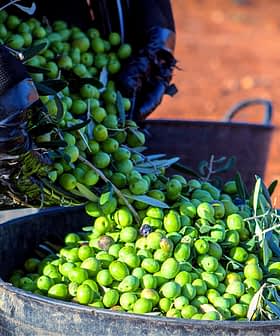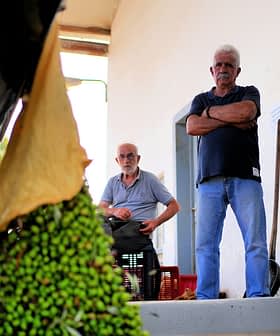Spanish Olive Oil Prices Fall as Production Recovers
A substantial harvest in Spain, already at 1.38 million metric tons and rising, has resulted in olive oil prices plummeting to levels not seen since mid-2022.
 The olive groves in Villacarillo, Jaén, home to Spain's largest olive oil mill (Photo: Daniel Dawson)
The olive groves in Villacarillo, Jaén, home to Spain's largest olive oil mill (Photo: Daniel Dawson) Spain produced 1.38 million metric tons of olive oil in the 2024/25 crop year, falling short of the 1.65 million tons forecasted, but still a significant increase from previous years due to favorable weather conditions. As a result of the bumper harvest, olive oil stocks have increased, leading to a substantial decrease in prices for both extra virgin and virgin olive oils in supermarkets.
According to the country’s Ministry of Agriculture, Fisheries and Food, Spain produced 1.38 million metric tons of olive oil in the 2024/25 crop year, with most olives harvested and milled.
While this year’s yield will not reach the 1.65 million tons predicted before the harvest started in October, it is significantly more than the 665,800 tons produced in 2022/23 and 852,600 tons the year after.
Spain was poised for a bumper harvest after a wet winter and mild spring temperatures. However, a lack of rain at the end of summer and the beginning of autumn, extreme weather events, including hail, and labor shortages resulted in a lower production total.
See Also:Olive Oil Exports from Spain Reach Record High, Defying Production HurdlesThe southern Spanish autonomous community of Andalusia led the way, with production reaching nearly 981,000 tons by the end of January, shortly before the latest national production data were published. By comparison, Andalusia produced 574,295 tons in the previous crop year.
The most significant increases were in the province of Jaén, where production more than doubled, rising from 205,387 tons in 2023/24 to 469,562 tons by the end of January.
“We still have February and part of March, which could add a few more tons to total production,” said Luis Carlos Valero, manager and spokesperson for the Association of Young Farmers in Jaén (Asaja-Jaén).
Other notable increases were seen in the neighboring provinces of Córdoba (from 150,084 to 245,205 tons) and Granada (55,314 to 105,222 tons).
Spain’s second and third-largest olive oil-producing regions, Castille-La Mancha and Extremadura, also experienced significant production increases.
Aut. Community | 2024/25 prov. (mT) | 2023/24 (mT) | % Change |
Andalusia | 980,994 | 574,295 | 71 |
Aragón | 7,152 | 17,573 | ‑59 |
Balearic Islands | 244 | 1,247 | -80 |
Basque Country | 122 | 105 | 16 |
Castille-La Mancha | 130,672 | 108,620 | 20 |
Castille and León | 1,429 | 1,497 | -0.3 |
Catalonia | 14,852 | 32,057 | -44 |
Extremadura | 76,442 | 68,721 | 11 |
Galicia | – | 6 | – |
La Rioja | 2,826 | 2,657 | 6 |
Madrid | 3,659 | 3,202 | 14 |
Murcia | 4,209 | 7,828 | -46 |
Navarre | 7,041 | 6,521 | 8 |
Valencia | 4,919 | 22,498 | -78 |
By the end of January, farmers and millers in Castille-La Mancha produced 130,672 tons compared to 108,620 tons in 2023/24.
Julián Martínez Lizán, the regional agriculture minister, told local media that he expected the harvest to finish “higher than the average of the last decade,” at 140,000 tons.
Meanwhile, production in neighboring Extremadura rose from 68,721 tons in 2023/24 to 76,442 tons in the first four months of the crop year, which began on October 1st.
As a result of the bumper harvest, olive oil stocks have risen to 865,176 tons, and Spanish authorities anticipate that Spain will finish the 2024/25 crop year in September with 295,389 tons.
By comparison, Spain finished January 2024 with 733,900 tons and the 2023/24 crop year with 190,389 tons of olive oil stocks.
The return of an average harvest and recovery of olive oil stocks has resulted in a dramatic decrease in prices at origin with a more gradual decline in supermarket prices.
Data from InfaOliva show that extra virgin olive oil prices have declined substantially from the record-high €8.988 per kilogram in January 2024 to €3.933 at the time of writing.
Similarly, virgin olive oil prices fell from €8.717 to €3.663 per kilogram, while lampante dropped from €8.563 to €3.490.
According to reporting from Las Provincias, prices have also declined for extra virgin olive oils across several major supermarket chains, ranging from a €0.20 drop for a liter to a €0.60 decline for three liters.
Victor Roig, the general manager of Deoleo in Spain, told Las Provincias that he expects production to reach 1.4 million tons in Spain with downward pressure on prices remaining.
“When there is no product, it is reflected in the prices, and then there is, it is noticeable in the very significant drop that is clearly seen on the shelves, and it is the trend that will continue until the next harvest,” he said.
“The logical thing is that we go to the prices of 2021 and 2022, between €3 and €4,” Roig added. “The whole context is positive for both the category and the consumer.”
Share this article









